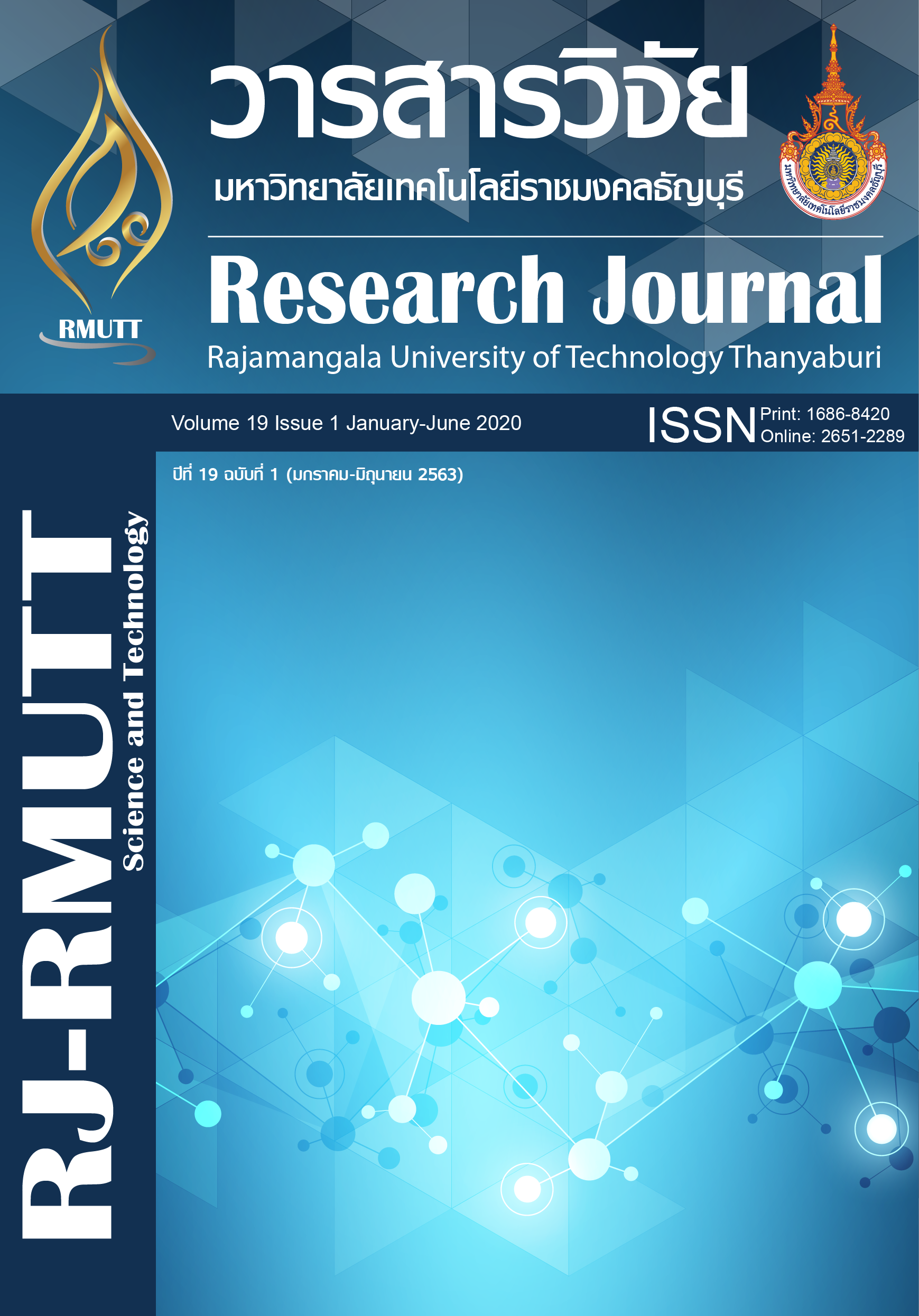Effect of Pectin from Watermelon Rind on Quality of Roselle (Hibiscus sabdariffa L.) Jam
Main Article Content
Abstract
This research aimed to determine the chemical and physical properties of pectin from watermelon rind and applied the extracted pectin for roselle jam production. The white and green parts of watermelon rind were boiled, dried (60 °C, 15 hours), and extracted by using 0.05 M hydrochloric acid and distilled water at 90 °C with an extraction time of 60 min. The results showed that the optimal extraction method to extract pectin from watermelon rind was hydrochloric acid extraction because of the moisture, ash, methoxyl content and degree of esterification (%DE) of extracted pectin were the most similar to the commercial pectin. The obtained pectin can be categorized as high methoxyl pectin (HMP). The extracted pectin was applied to the roselle jam product. The concentration of pectin from watermelon rind was varied at 0.10, 0.49, and 0.89 %, compared with commercial pectin (0.49 %). Results showed that roselle jam added with the watermelon pectin and control were not significantly different in color, total soluble solid, pH, and titratable acidity. All treatments showed that L*, a*, and b* values were in the ranges of 20.97-21.80, 0.37-0.77 and 2.27-2.90, respectively. Sensory evaluation of appearance, color, odor, taste, texture, and overall acceptance results indicated that roselle jam added with the watermelon pectin and control were not significantly different. However, results indicated that the jam with 0.89 % watermelon rind pectin had a high overall acceptance which was not different from the commercial pectin. Therefore, pectin from watermelon rind could potentially be used for replacement of the commercial pectin in the food industry.
Article Details

This work is licensed under a Creative Commons Attribution-NonCommercial-NoDerivatives 4.0 International License.
References
ธานุวัฒน์ ลาภตันศุภผล, ปฏิมา ทองขวัญ, ศิริลักษณ์ สรงพรมทิพย์. การสกัดเพคตินจากเปลือกผักและผลไม้. วารสารวิทยาศาสตร์เกษตร. 2556;44(2 พิเศษ):433-6.
ชวนิฏฐ์ สิทธิดิลกรัตน์, พิลาณี ไวถนอมสัตย์, จิราพร เชื้อกูล, ปริศนา สิริอาชา. การผลิตเพคตินจากเปลือกและกากส้มเหลือทิ้ง. ใน: รายงานการประชุมวิชาการของมหาวิทยาลัยเกษตรศาสตร์ครั้งที่ 43; วันที่ 1-4 ก.พ. 2548; มหาวิทยาลัยเกษตรศาสตร์. กรุงเทพ: 2548. น. 469-80.
สุธิดา ทองคำ. การสกัดเพคตินจากจาวตาลและเมล็ดตาลอ่อน. วารสารวิทยาศาสตร์แห่งมหาวิทยาลัยราชภัฎเพชรบุรี. 2554;8(1):45-50.
มาริษา ไชยโอสถ. การสกัดเพกตินจากของเหลือทิ้งของขนุน [วิทยานิพนธ์ปริญญามหาบัณฑิต]. ชลบุรี: มหาวิทยาลัยบูรพา; 2549.
นวลกมล อำนวยสิน, ณัฐญากรณ์ เสือชุมแสง, เทพปัญญา เจริญรัตน์. วารสารวิทยาศาสตร์และเทคโนโลยี. 2561;7(5 เสริม):481-90.
ขนิษฐา เลิกชัยภูมิ. การสกัดเพคตินจากส้มมะงั่วและการใช้ประโยชน์ในระบบอาหาร [วิทยานิพนธ์ปริญญามหาบัณฑิต]. ขอนแก่น: มหาวิทยาลัยขอนแก่น; 2545.
ณรงค์ ศิขิรัมย์. การสกัดและการหาลักษณะของเพคติน [วิทยานิพนธ์ปริญญามหาบัณฑิต]. เชียงใหม่: มหาวิทยาลัยเชียงใหม่; 2546.
Association of Official Analytical Chemist (AOAC). Official Method of Analysis (15th ed.) Arington Virginia: Association of Official Analytical Chemist; 1990.
Ranganna S. Handbook of Analysis and Quality Control for Fruit and Vegetable Products. Tata McGraw-Hill Publishing Company, New Delhi, India; 1986.
Nwanekezi EC, Alawuba OCG, Mkpolulu, CCM. Characterization of Pectic Substances from Selected Tropical Fruits [Master’s thesis]. Abia State Nigeria: Graduated School, Abia State University; 1992.
นันทกร บุญเกิด, ลําไพร ดิษฐวิบูลย์. คู่มือการแปรรูปองุ่นและผลไม้อื่นๆ เป็นแยมเจลลี่และนํ้าผลไม้พร้อมดื่ม. พิมพ์ครั้งที่ 1. นครราชสีมา: โอนลี่ เบสท์ ดีไซน์ แอนด์ พริ้นติ้ง; 2544.
YAPO BM. Pectin quantity, composition and physicochemical behaviour as influenced by the purification process. Food Res Int. 2009;42(8):1197–202.
Hussein RM, Shahein YE, Hakim AEE, Awad HM. Biochemical and molecular characterization of three colored types of Roselle (Hibiscus sabdariffa L.). J Am Sci. 2010;6:726-33.
นงลักษณ์ งามพีระพงศ์. การพัฒนาผลิตภัณฑ์แยมกระเจี๊ยบแดงลดน้ำตาล [วิทยานิพนธ์ปริญญามหาบัณฑิต]. กรุงเทพ: มหาวิทยาลัยเกษตรศาสตร์; 2557.
Patras A, Brunton NP, Tiwari BK, Butler F. Stability and degradation kinetics of bioactive compounds and colour in strawberry jam during storage. Food and Bioprocess Tech. 2011;4:1245-52.


